Abstract
Previous work in transfected cell lines and in nuclear extracts has led to the identification of two cis-acting elements important for transcription of the human alpha-1-antitrypsin (A1AT) gene, which bind to two liver specific trans-acting factors, LF-A1 and LF-B1. Mutations EM3 and PM1, which abolish the binding of LF-A1 and LF-B1 respectively, drastically reduce transcription activity of the A1AT gene in vitro and in cell culture. The same mutants have now been introduced in a larger DNA context and their effect has been tested in transgenic mice. A stretch of DNA was constructed which carries two transcriptional units: 18 kb of the human retinol binding protein (RBP) gene, driving the expression of the bacterial chloramphenicol acetyl transferase, linked to 17.5 kb containing the entire A1AT coding sequence with additional 5' and 3' flanking sequences. Transcription from the RBP promoter was shown to predominate in liver, and could be used as an internal marker of 'active copy number'. Mutations in the A1AT gene promoter were introduced by homologous recombination in bacterial cells. The results show that base pair substitutions in the binding site for LF-A1 and LF-B1 drastically reduce transcription in non-hepatic adult tissues, yolk sac, and fetal liver, whereas only LF-B1 binding site mutations have a marked, albeit variable, effect in adult liver.
Full text
PDF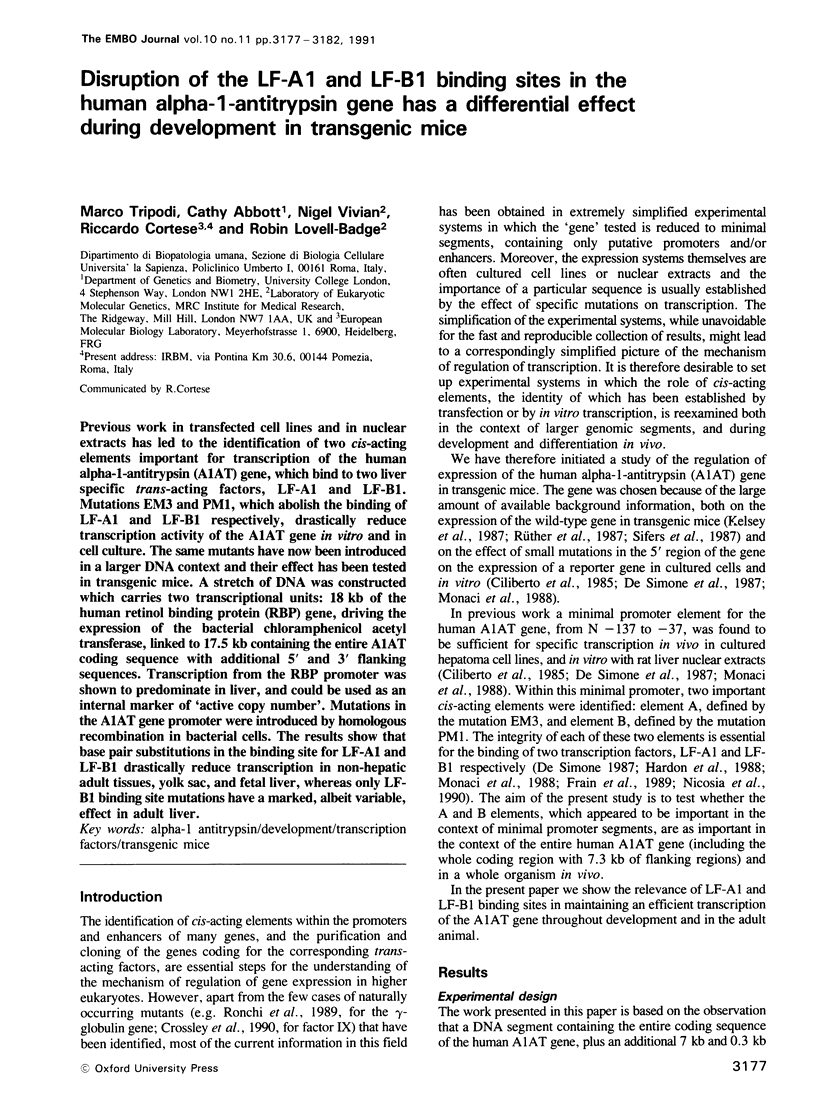
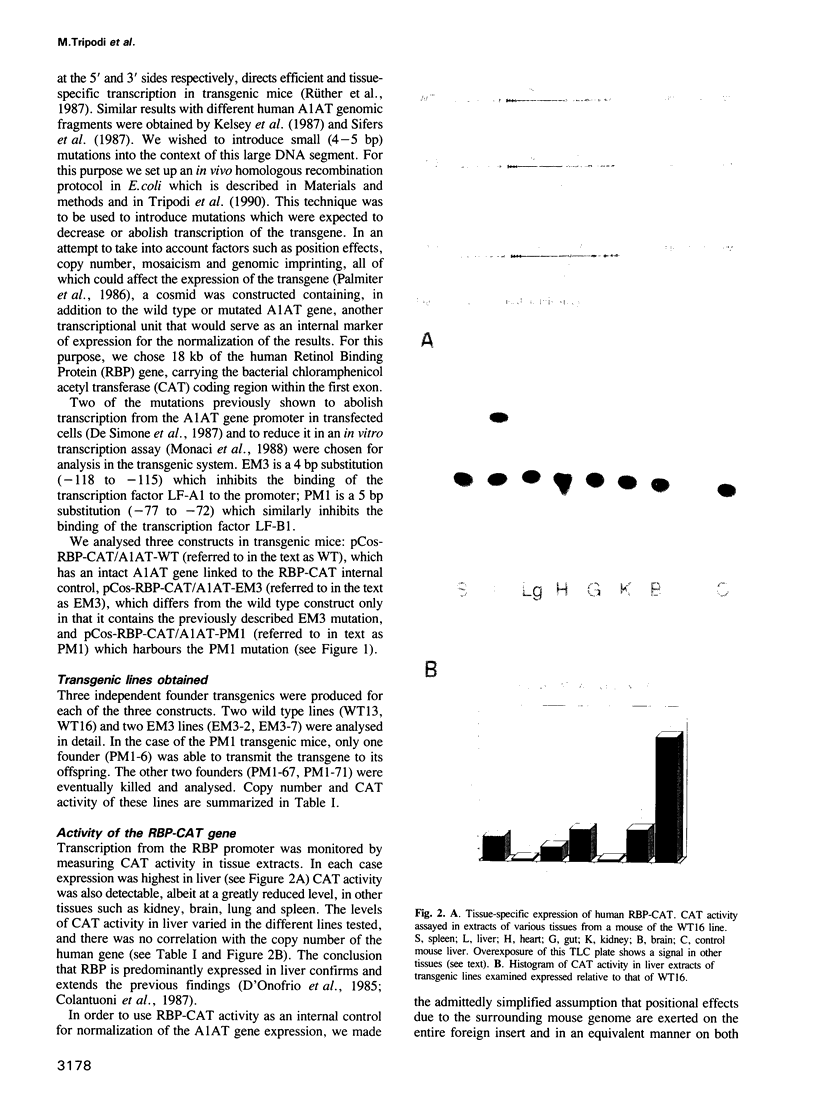
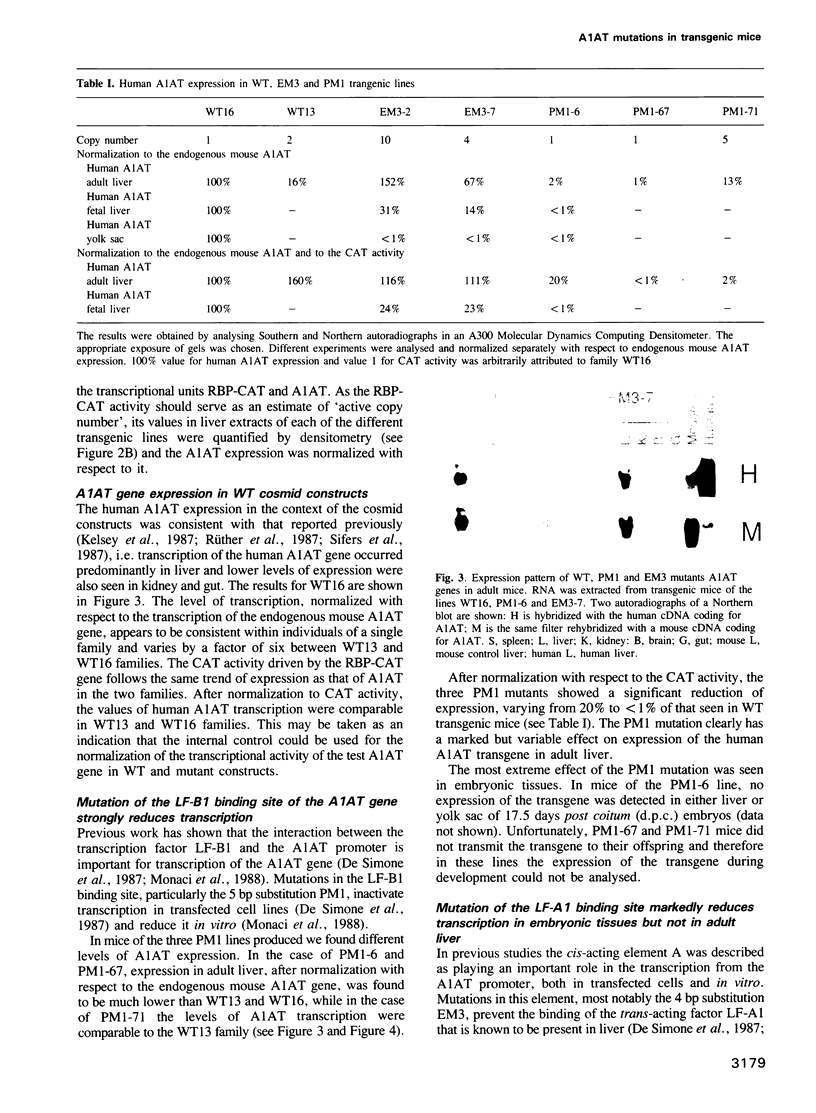
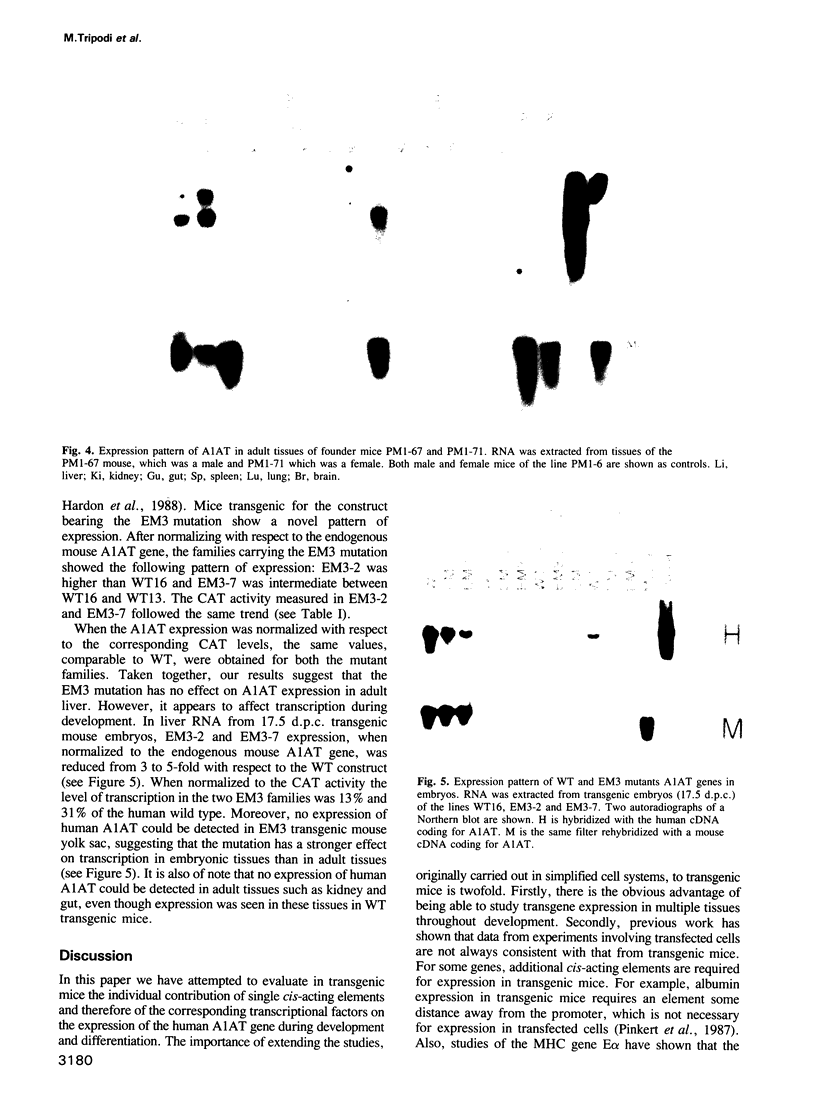
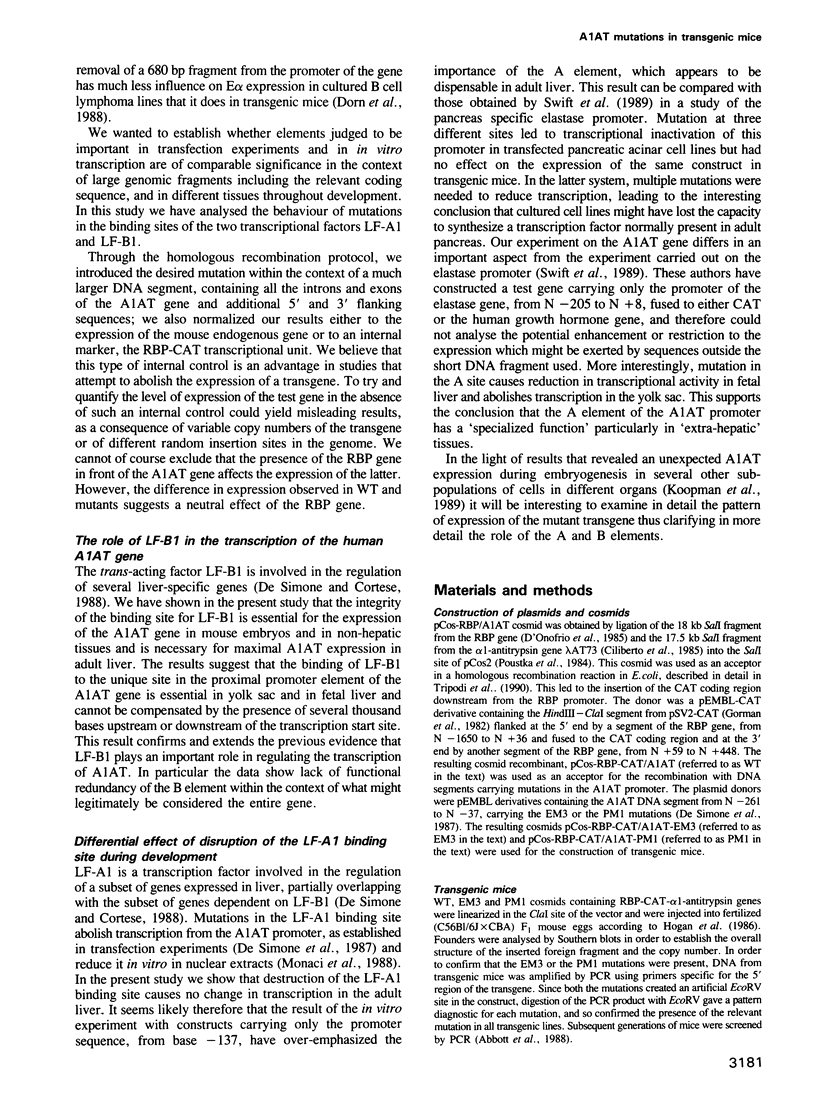
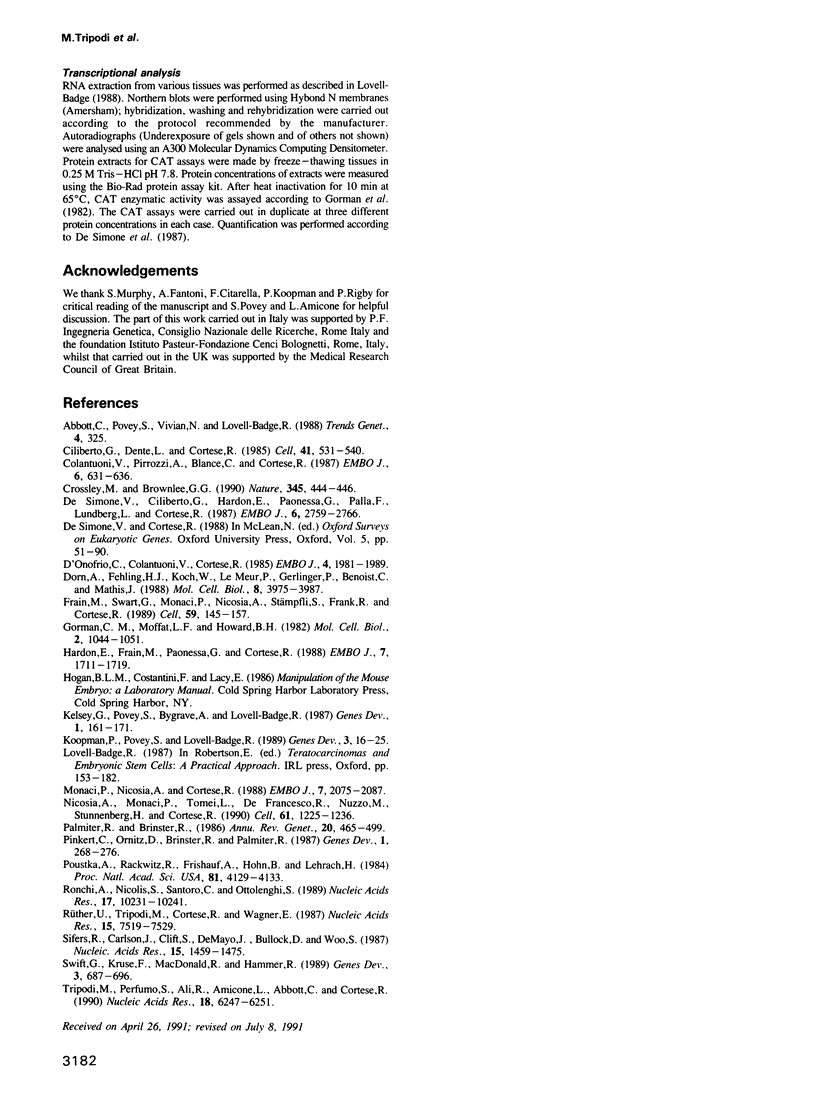
Images in this article
Selected References
These references are in PubMed. This may not be the complete list of references from this article.
- Abbott C., Povey S., Vivian N., Lovell-Badge R. PCR as a rapid screening method for transgenic mice. Trends Genet. 1988 Nov;4(11):325–325. doi: 10.1016/0168-9525(88)90114-x. [DOI] [PubMed] [Google Scholar]
- Ciliberto G., Dente L., Cortese R. Cell-specific expression of a transfected human alpha 1-antitrypsin gene. Cell. 1985 Jun;41(2):531–540. doi: 10.1016/s0092-8674(85)80026-x. [DOI] [PubMed] [Google Scholar]
- Colantuoni V., Pirozzi A., Blance C., Cortese R. Negative control of liver-specific gene expression: cloned human retinol-binding protein gene is repressed in HeLa cells. EMBO J. 1987 Mar;6(3):631–636. doi: 10.1002/j.1460-2075.1987.tb04801.x. [DOI] [PMC free article] [PubMed] [Google Scholar]
- Crossley M., Brownlee G. G. Disruption of a C/EBP binding site in the factor IX promoter is associated with haemophilia B. Nature. 1990 May 31;345(6274):444–446. doi: 10.1038/345444a0. [DOI] [PubMed] [Google Scholar]
- D'Onofrio C., Colantuoni V., Cortese R. Structure and cell-specific expression of a cloned human retinol binding protein gene: the 5'-flanking region contains hepatoma specific transcriptional signals. EMBO J. 1985 Aug;4(8):1981–1989. doi: 10.1002/j.1460-2075.1985.tb03881.x. [DOI] [PMC free article] [PubMed] [Google Scholar]
- De Simone V., Ciliberto G., Hardon E., Paonessa G., Palla F., Lundberg L., Cortese R. Cis- and trans-acting elements responsible for the cell-specific expression of the human alpha 1-antitrypsin gene. EMBO J. 1987 Sep;6(9):2759–2766. doi: 10.1002/j.1460-2075.1987.tb02570.x. [DOI] [PMC free article] [PubMed] [Google Scholar]
- Dorn A., Fehling H. J., Koch W., Le Meur M., Gerlinger P., Benoist C., Mathis D. B-cell control region at the 5' end of a major histocompatibility complex class II gene: sequences and factors. Mol Cell Biol. 1988 Oct;8(10):3975–3987. doi: 10.1128/mcb.8.10.3975. [DOI] [PMC free article] [PubMed] [Google Scholar]
- Frain M., Swart G., Monaci P., Nicosia A., Stämpfli S., Frank R., Cortese R. The liver-specific transcription factor LF-B1 contains a highly diverged homeobox DNA binding domain. Cell. 1989 Oct 6;59(1):145–157. doi: 10.1016/0092-8674(89)90877-5. [DOI] [PubMed] [Google Scholar]
- Gorman C. M., Moffat L. F., Howard B. H. Recombinant genomes which express chloramphenicol acetyltransferase in mammalian cells. Mol Cell Biol. 1982 Sep;2(9):1044–1051. doi: 10.1128/mcb.2.9.1044. [DOI] [PMC free article] [PubMed] [Google Scholar]
- Hardon E. M., Frain M., Paonessa G., Cortese R. Two distinct factors interact with the promoter regions of several liver-specific genes. EMBO J. 1988 Jun;7(6):1711–1719. doi: 10.1002/j.1460-2075.1988.tb03000.x. [DOI] [PMC free article] [PubMed] [Google Scholar]
- Kelsey G. D., Povey S., Bygrave A. E., Lovell-Badge R. H. Species- and tissue-specific expression of human alpha 1-antitrypsin in transgenic mice. Genes Dev. 1987 Apr;1(2):161–171. doi: 10.1101/gad.1.2.161. [DOI] [PubMed] [Google Scholar]
- Koopman P., Povey S., Lovell-Badge R. H. Widespread expression of human alpha 1-antitrypsin in transgenic mice revealed by in situ hybridization. Genes Dev. 1989 Jan;3(1):16–25. doi: 10.1101/gad.3.1.16. [DOI] [PubMed] [Google Scholar]
- Monaci P., Nicosia A., Cortese R. Two different liver-specific factors stimulate in vitro transcription from the human alpha 1-antitrypsin promoter. EMBO J. 1988 Jul;7(7):2075–2087. doi: 10.1002/j.1460-2075.1988.tb03047.x. [DOI] [PMC free article] [PubMed] [Google Scholar]
- Nicosia A., Monaci P., Tomei L., De Francesco R., Nuzzo M., Stunnenberg H., Cortese R. A myosin-like dimerization helix and an extra-large homeodomain are essential elements of the tripartite DNA binding structure of LFB1. Cell. 1990 Jun 29;61(7):1225–1236. doi: 10.1016/0092-8674(90)90687-a. [DOI] [PubMed] [Google Scholar]
- Palmiter R. D., Brinster R. L. Germ-line transformation of mice. Annu Rev Genet. 1986;20:465–499. doi: 10.1146/annurev.ge.20.120186.002341. [DOI] [PMC free article] [PubMed] [Google Scholar]
- Pinkert C. A., Ornitz D. M., Brinster R. L., Palmiter R. D. An albumin enhancer located 10 kb upstream functions along with its promoter to direct efficient, liver-specific expression in transgenic mice. Genes Dev. 1987 May;1(3):268–276. doi: 10.1101/gad.1.3.268. [DOI] [PubMed] [Google Scholar]
- Poustka A., Rackwitz H. R., Frischauf A. M., Hohn B., Lehrach H. Selective isolation of cosmid clones by homologous recombination in Escherichia coli. Proc Natl Acad Sci U S A. 1984 Jul;81(13):4129–4133. doi: 10.1073/pnas.81.13.4129. [DOI] [PMC free article] [PubMed] [Google Scholar]
- Ronchi A., Nicolis S., Santoro C., Ottolenghi S. Increased Sp1 binding mediates erythroid-specific overexpression of a mutated (HPFH) gamma-globulin promoter. Nucleic Acids Res. 1989 Dec 25;17(24):10231–10241. doi: 10.1093/nar/17.24.10231. [DOI] [PMC free article] [PubMed] [Google Scholar]
- Rüther U., Tripodi M., Cortese R., Wagner E. F. The human alpha-1-antitrypsin gene is efficiently expressed from two tissue-specific promotors in transgenic mice. Nucleic Acids Res. 1987 Sep 25;15(18):7519–7529. doi: 10.1093/nar/15.18.7519. [DOI] [PMC free article] [PubMed] [Google Scholar]
- Sifers R. N., Carlson J. A., Clift S. M., DeMayo F. J., Bullock D. W., Woo S. L. Tissue specific expression of the human alpha-1-antitrypsin gene in transgenic mice. Nucleic Acids Res. 1987 Feb 25;15(4):1459–1475. doi: 10.1093/nar/15.4.1459. [DOI] [PMC free article] [PubMed] [Google Scholar]
- Swift G. H., Kruse F., MacDonald R. J., Hammer R. E. Differential requirements for cell-specific elastase I enhancer domains in transfected cells and transgenic mice. Genes Dev. 1989 May;3(5):687–696. doi: 10.1101/gad.3.5.687. [DOI] [PubMed] [Google Scholar]
- Tripodi M., Perfumo S., Ali R., Amicone L., Abbott C., Cortese R. Generation of small mutation in large genomic fragments by homologous recombination: description of the technique and examples of its use. Nucleic Acids Res. 1990 Nov 11;18(21):6247–6251. doi: 10.1093/nar/18.21.6247. [DOI] [PMC free article] [PubMed] [Google Scholar]
- de Simone V., Cortese R. The transcriptional regulation of liver-specific gene expression. Oxf Surv Eukaryot Genes. 1988;5:51–90. [PubMed] [Google Scholar]






